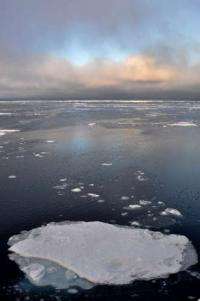Polar clouds and sunset colors over the Arctic sea ice. Clouds in the Arctic have a large influence on the sea ice amount by affecting the balance of sunlight energy. Credit: U.S. Geological Survey/photo by Jessica K. Robertson.
(PhysOrg.com) -- Arctic clouds are strongly tied to Arctic sea ice loss. To find the strength of those ties, a team led by scientists at Pacific Northwest National Laboratory tested a prominent climate model with observed data and found that it significantly underestimates liquid water content in specific Arctic clouds, which affects how much solar energy transfers to the sea ice. They point out the areas of bias and recommend specific improvements to reduce those shortcomings. Their study is published in the Journal of Geophysical Research.
Stand under a cover of dense clouds on a sunlit day. Feeling cooler? Clouds over the Earth's poles get in the way of sunlight and the energy it carries to the surface. As a result, they can strongly affect Arctic climate change. In 2007, the reduction of clouds contributed to the unprecedented summer sea ice loss by increasing what scientists call the ice-albedo feedbacks. Even though sea ice is highly reflective, with enough solar energy it will melt. As more ice melts, there is less reflectivity and more heat absorbed in the surrounding ocean or land, and thus, more melting. This describes the feedback loop. To correctly predict future Arctic sea ice change, climate models must have a realistic simulation of Arctic cloud cover as well as cloud liquid water amount.
Led by Dr. Xiaohong Liu, an atmospheric scientist at PNNL, researchers tested the Community Atmospheric Model version 5 (CAM5), through two model frameworks. Both the Cloud-Associated Parameterizations Testbed (CAPT) and the Single-Column Modeling (SCM) testbed were used. CAPT and SCM are proven useful ways to understand climate model errors. The model results were compared and validated with the observational data obtained during the Department of Energy Atmospheric Radiation Measurement (ARM) Indirect and Semi-Direct Aerosol Campaign (ISDAC) campaign conducted in April 2008 and the Mixed-Phase Arctic Cloud Experiment (M-PACE) campaign conducted in October 2004 near the ARM North Slope of Alaska site.
Computational models that simulate the climate such as CAM5, which is the atmosphere component of the Community Earth System Model used in the Intergovernmental Panel on Climate Change 5th Assessment, are used to predict future climate changes, such as the Arctic sea ice loss.
This study identifies areas for model improvements of cloud microphysics and aerosol parameterizations, to reduce the bias in CAM5.
Based on the findings from this study, the scientists will improve the cloud microphysics and aerosol representations in CAM5, in collaboration with scientists at the National Center for Atmospheric Research. The impacts of these improvements on global climate will be assessed. These new improvements will likely be in the future community releases of CAM5.
More information: Liu X, et al. 2011. "Testing Cloud Microphysics Parameterizations in NCAR CAM5 with ISDAC and M-PACE Observations." Journal of Geophysical Research, 116, D00T11. DOI:10.1029/2011JD015889.
Journal information: Journal of Geophysical Research
Provided by Pacific Northwest National Laboratory






















